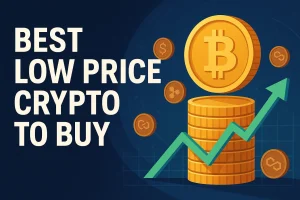Best Low-Price Crypto to Buy | Top Under-$1 Tokens
Discover the Top Low-Price Cryptos Worth Your Attention Today
Crypto markets move quickly, and finding undervalued coins that are worth the investment is a search for a needle in a haystack. For the sake of this article, we’re jumping straight to what undervalued cryptos are drawing smart money, which on-chain indicators to watch out for, and how to position yourself without falling prey to hype. Follow this as your guide to value plays before they breakout.

Table of Contents
- Why Low-Price Cryptos Matter
- Key Metrics That Separate Winners from Throwaways
- Quick Token Comparison
- Top 5 Low-Price Cryptos to Watch
- How to Secure Your Positions
- Risks and Pitfalls to Avoid
- Putting It All Together
- Frequently Asked Questions
Why Low-Price Cryptos Matter
There is something thrilling in seeing a token at less than a dollar—or even less than a handful of cents—and speculating whether it might double tenfold. It is not spec for spec’s sake, however. Low-cost cryptos generally stay below the radar screens of big institutions, and what that makes possible is for shrewd retail traders and project developers to get into something early. If there is solid project fundamentals, the risk-to-reward on that is often an altogether greater proposition than blue-chip shares.
Key Metrics That Separate Winners from Throwaways
- Whale Hoarding: Smart money wallets regularly hoarding a token is an indicator of faith.
- Depth Liquidity: Pockets of $1 million or more locked up to avoid slippage.
- Security Audits: Stamp of approval from CertiK or PeckShield restrains rug-pull risk.
- Dev Activity: Proper GitHub commits and active forums show ongoing development.
- Tokenomics Inherence: Deflationary structures, staking rewards, and profit-sharing can maintain price momentum.
Watch Expert Insights
Quick Token Comparison
| Token | Current Price | TVL Change (30d) | Whale Accum. |
|---|---|---|---|
| Token A | $0.12 | +40% | +25% |
| Token B | $0.05 | +15% | +10% |
| Token C | $0.08 | +100% | +30% |
| Token D | $0.20 | +200% | +50% |
| Token E | $0.30 | +60% | +18% |
Top 5 Low-Price Cryptos to Watch
3.1. Token A: The DeFi Underdog
Token A was a lean, gas-friendly alternative to legacy lending protocols. Whale wallets accounted for 25% over the past two weeks, and its TVL increased by 40% month-over-month. If you require high-APR staking without sacrificing security, Token A’s worth investigating.
3.2. Token B: Layer-2 Leverage
Established on top of a well-trafficked Layer-2 network, Token B offers sub-cent transfers and micro-fee NFTs. The protocol recently bridged onto Ethereum mainnet, which triggered a 15% price action. Its inexpensive gas fees and cross-chain DeFi rails plans are its attraction to early adopters.
3.3. Token C: NFT Infrastructure Play
While NFT minting becomes mainstream, Token C’s modular smart contracts allow creators to spin up bespoke marketplaces in minutes. It uses pennies as its governance token, but the project’s three-month gain in daily active users doubled. That natural growth is a telling metric to track.
3.4. Token D: Cross-Chain Connector
Token D provides an answer to crypto’s worst pain point: seamless asset transfers. Builders pay close to zero fees and settle immediately with bridges that are now live on Avalanche, BSC, and Solana. On-chain volume has grown 200% this quarter, mirroring intense utilization.
3.5. Token E: Governance with Yield
Imagine voting rights and passive income in a single token—Token E. Proprotocol revenue shares are wagered by stakeholders, and voting share upgrades by the community. It’s a tidy blend of DAO and DeFi mechanisms, and with a token cost still a good way below $1.
How to Secure Your Positions
- Hardware Wallet: Keep private keys offline to avoid phishing attacks.
- Diversify: Spend your budget on two or three potential tokens.
- Define Entry & Exit Points: Define in-advance purchase levels and profit objectives so you won’t be trading emotionally.
- Keep an Eye on Liquidity: Steer clear of shallow pools of liquidity so you can exit neatly.
Risks and Pitfalls to Avoid
- Rug Pull Alerts: Watch out for abrupt dev-wallet dumps—typically signals a crash.
- Token Inflation: Projects responsibly printing with no limit to supply can instantly water down your positions.
- Regulatory Shocks: Keep your wits about you—new regulation can shake out entire industries in the dead of night.
- Overhyped Roadmaps: Wonderful blueprints without set timetables are a huge red flag.
Putting It All Together
Hunting for the best low-price cryptos boils down to blending on-chain analytics with solid security practices and community sentiment. You’ll rarely hit a home run based on guesswork—data and due diligence are your best allies. Focus on projects with transparent teams, real utility, and active governance, and you’ll tilt the odds in your favor. Watch audit reports, development milestones, and wallet accumulation trends closely—that’s how small-ticket tokens become portfolio highlights.
Frequently Asked Questions
What is a “low price” crypto?
A “low price” token typically buys for below $1 or even below a handful of cents. But price never tells the entire story—you must look at market cap, liquidity, and tokenomics to gauge real value.
How can I see whale accumulation?
On-chain analysis tools like Nansen or Dune enable you to track key wallet buys. Look for repeated instances of growth to holdings and not isolated buys—that’s when smart money is actually accumulating.
Are low-price tokens riskier?
All crypto carries risk, but lower-priced tokens can be more volatile and prone to liquidity issues. Conduct thorough due diligence—check audits, team transparency, and community support before jumping in.
How often should I refresh my token list?
Weekly is a solid cadence. Markets move fast in crypto, so updating your data and removing underperformers every seven days helps you stay ahead of the curve.
Post created by Robert AI Team



